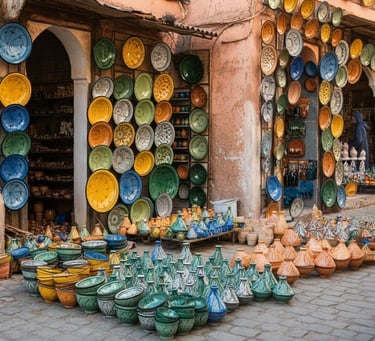Morocco's Pottery Capitals: A Journey Through Heritage
CULTURE & HERITAGE


Morocco's cultural and historical context intricately connects to the flourishing heritage of pottery manufacturing. Throughout, numerous localities stand out for their exceptional contributions to Moroccan ceramics, each offering a glimpse into the rich tradition and creative excellence that define Moroccan pottery. Let us explore these prominent pottery cities to reveal their importance and craftsmanship.
Fez: The Epicenter of Moroccan Ceramics Fez, one of Morocco's oldest and culturally affluent towns, is often considered the epicenter of Moroccan pottery. Fez's ceramic legacy dates back to the 9th century, making it a fundamental element of Morocco's cultural history. The city's renown is mostly based on its elaborate tilework, termed zellige—a craft that exemplifies geometric perfection, vivid hues, and the harmonious integration of art and architecture. The walls of castles, mosques, and fountains around Morocco are often embellished with zellige, exemplifying the exquisite workmanship inherited through centuries. The artists of Fez are known for crafting not just tiles but also a diverse range of ceramic objects, including ornamental plates, bowls, and vases. The artistry includes precise hand-painting and glazing techniques that have been refined over time. Fez's ceramic pottery stands out for its meticulous detail, featuring delicate floral and geometric motifs on each piece. These designs often exhibit influences of Islamic art, which prioritizes symmetry and order, resulting in creations that are both utilitarian and profoundly creative. Despite the passing of time, Fez's potters continue to use ancient techniques, ensuring that each artifact retains its historical significance. Inside the city's renowned pottery studios, craftsmen engage in their craft, preserving traditional methods and transforming Fez into a vibrant museum of Morocco's ceramic heritage for contemporary visitors.
Meknes: Merging Tradition with Practicality Meknes, a city renowned for its imperial heritage, enhances Morocco’s ceramic culture by emphasizing utility. Meknes is renowned for its utilitarian pottery, in contrast to the elaborate artifacts of Fez. The pottery of Meknes is renowned for its tagines, kitchenware, and serving dishes, which exemplify the city's focus on creating functional but aesthetically pleasing art. The artists of Meknes adeptly combine creative expression with functionality, creating ceramics that fulfill everyday purposes while retaining aesthetic allure. Traditional Moroccan motifs, such as vibrant colors and geometric patterns, characterize Meknes pottery, and the artists are renowned for their durability and skill. These items are designed for durability, reflecting the quality of materials and the craftsmen's expertise. Meknes has distinguished itself among Moroccan ceramics by creating pottery that resonates with both emotion and craftsmanship. Meknes meticulously produces the items, and their designs embody the region's reverence for tradition while accommodating contemporary requirements. Meknes pottery's pragmatism enhances its aesthetic appeal; rather, it intensifies the interplay between form and function, establishing a harmony that has positioned Meknes as a significant contributor to the Moroccan ceramic legacy.
Safi: The Elegance of Blue and White Safi, situated on Morocco's Atlantic coast, is renowned for its blue and white ceramics, a distinctive feature of its pottery heritage. The unique blue glaze of Safi, sometimes complemented by elaborate white designs, has garnered the city a worldwide reputation for crafting some of Morocco's most sophisticated ceramics. The color contrast in Safi ceramics is vivid, with rich blues representing the adjacent ocean and the city's maritime character. Safi's artists excel in various ceramic processes, particularly glazing and firing, producing pottery renowned for its durability and aesthetic appeal. Safi's pottery often showcases floral and geometric themes, reflecting its Islamic and Berber artistic heritage, and is used to create a diverse range of items, including vases, plates, and kitchenware. Although Safi's pottery adheres to traditional styles and techniques, the city has also welcomed local creativity. The excellence and craftsmanship of Safi ceramics render them highly coveted both domestically and globally, therefore sustaining the city's cultural legacy. Visitors to Safi can explore its extensive ceramic heritage at the National Museum of Ceramics, which highlights the intricacy of artistry and innovation that characterizes the city's pottery sector.
Tetouan: A Northern Jewel of Ceramics Tetouan, located in northern Morocco, is another jewel in the nation's ceramic heritage. Tetouan's pottery is renowned for its vivid and elaborate ceramics, characterized by brilliant motifs and complex patterns that often blend traditional Moroccan forms with Andalusian influences. Tetouan's closeness to Spain has endowed the area with a distinctive cross-cultural essence, particularly reflected in its pottery. Tetouan artists excel at creating both artistic and practical ceramics, including ornamental tiles and kitchenware. The patterns often include Berber, Arab, and Spanish creative influences, resulting in a distinctive amalgamation of styles that distinguishes Tetouan ceramics. The pottery of Tetouan usually exhibits vibrant colors and intricate patterns, making them visually arresting works that embody a spirit of creative celebration. Tetouan's contribution to Moroccan pottery is characterized by its fusion of tradition and modern innovation. The city's pottery studios consistently draw artists and designers aiming to merge traditional methods with contemporary creative trends. This dynamic methodology guarantees that Tetouan's pottery retains its significance while respecting the profound cultural traditions from which it originated.
Rabat: The Capital's Ceramic Artistry Rabat, the capital of Morocco, is a city renowned for its flourishing ceramic arts community. While not as globally recognized as Fez or Safi, Rabat's ceramic history stands out for its diversity and modernity. The city's artists have successfully integrated traditional Moroccan themes into contemporary ceramic shapes, producing items that attract both local and international customers. The pottery of Rabat exemplifies the city's multicultural character, including influences from several Moroccan regions and beyond. Recognized for their meticulousness and creative elegance, the city's ceramic arts produce both ornamental objects and useful wares. Artisans in Rabat persist in their innovation, merging legacy with modern design, yielding ceramics that reflect the city's dynamic cultural context. The city has several ceramic marketplaces and studios, allowing tourists to see the creative process directly. Rabat's pottery industry is critical for maintaining traditional artisanal practices while expanding the contemporary significance of Moroccan ceramics.
Summary
The cities of Fez, Meknes, Safi, Tetouan, and Rabat in Morocco each provide a distinct contribution to the nation's esteemed pottery culture. The complex zellige tiles of Fez, the useful and durable pottery of Meknes, the blue and white beauty of Safi, the bright creativity of Tetouan, and the contemporary ceramic inventions of Rabat each provide a unique dimension to the tapestry of Moroccan ceramics. These pottery capitals act as both custodians of heritage and innovators, guaranteeing that Moroccan pottery continues to be a dynamic and changing art form. Investigating these towns provides insight into Morocco's profound creative legacy and its continuous dedication to conserving and honoring its ceramic traditions.
